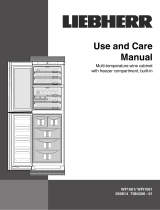
unless they are under continuous adult super-
vision.
-
When disconnecting the appliance from the
supply, always take hold of the plug. Do not
pull the cable.
-
In the event of a fault pull out the mains plug
or deactivate the fuse.
-
Do not damage the mains power cable. Do
not operate the appliance with a defective
mains power cable.
-
Only customer service or other specially
trained staff may repair or perform other oper-
ations on the appliance.
-
Only assemble, connect and dispose of the
appliance according to the instructions.
-
Please keep these instructions in a safe place
and pass them on to any subsequent owners.
Fire hazard:
-
The coolant used (information on the model
plate) is eco-friendly but also flammable. Any
leaking coolant may ignite.
•
Do not damage the refrigerant circuit pipes.
•
Do not handle ignition sources inside the
appliance.
•
Do not use electrical appliances inside the
appliance (e.g. steam cleaners, heaters, ice
cream makers, etc.).
•
If the refrigerant leaks: remove any naked
flames or ignition sources from the vicinity
of the leakage point. Properly air the room.
Inform customer services.
-
Do not store explosives or sprays using
combustible propellants such as butane,
propane, pentane, etc. in the appliance. To
identify these spray cans, look for the list
of contents printed on the can, or a flame
symbol. Gases possibly escaping may ignite
due to electrical components.
-
Keep burning candles, lamps and other items
with naked flames away from the appliance so
that they do not set the appliance on fire.
-
Please be sure to store alcoholic drinks or
other packaging containing alcohol in tightly
closed containers. Any alcohol that leaks out
may be ignited by electrical components.
Danger of tipping and falling:
-
Do not misuse the plinth, drawers, doors etc.
as a step or for support. This applies particu-
larly to children.
Danger of food poisoning:
-
Do not consume food which has been stored
too long.
Danger of frostbite, numbness and pain:
-
Avoid prolonged skin contact with cold
surfaces or refrigerated/frozen goods or take
protective measures, e.g wear use gloves.
Danger of injury and damage:
-
Hot steam can lead to injury. Do not use elec-
trical heating or steam cleaning equipment,
open flames or defrosting sprays to defrost.
-
Do not use sharp implements to remove the
ice.
Danger of crushing:
-
Do not hold the hinge when opening and
closing the door. Fingers may get caught.
Symbols on the appliance:
The symbol can be located on the
compressor. It refers to the oil in the
compressor and indicates the following
danger: Swallowing or inhaling can be fatal.
This is only relevant for recycling. There is no
danger in normal operation.
This symbol is found on the compressor and
indicates the danger of flammable materials.
Do not remove the sticker.
A sticker to this effect may be applied to
the rear of the appliance. It refers to the
foam-padded panels in the door and/or the
housing. This is only relevant for recycling. Do
not remove the sticker.
Please observe the specific information in
the other sections:
DANGER identifies a situation involving direct
danger which, if not obviated, may
result in death or severe bodily
injury.
WARNING identifies a dangerous situation
which, if not obviated, may result in
death or severe bodily injury.
CAUTION identifies a dangerous situation
which, if not obviated, may result in
minor or medium bodily injury.
NOTICE identifies a dangerous situation
which, if not obviated, may result in
damage to property.
Note It contains useful instructions and
tips.
General safety information
* Depending on model and options 5





















